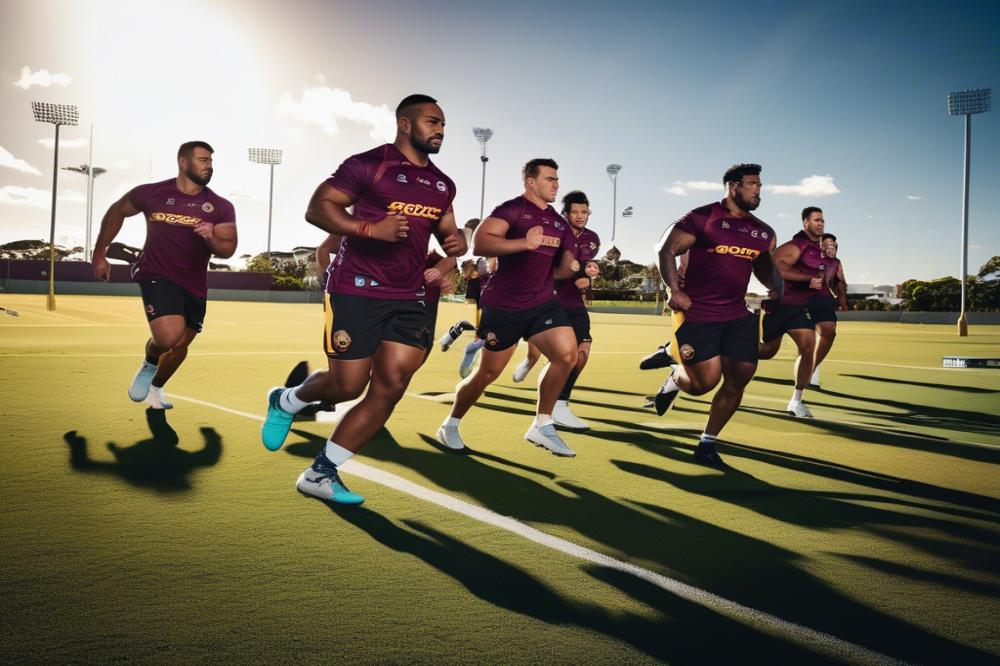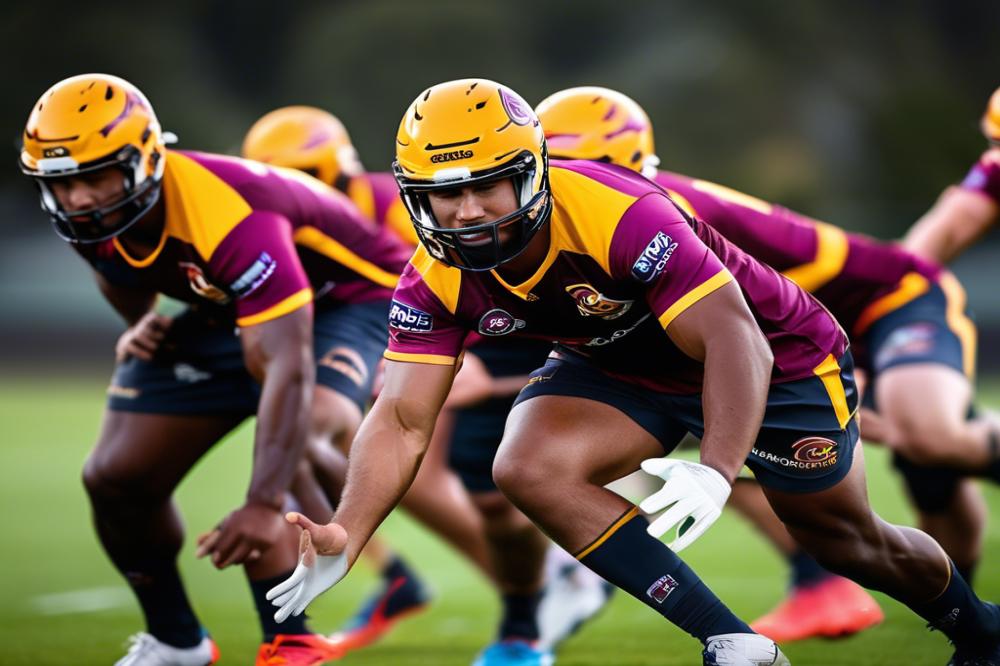Introduction
In the world of professional sports, fitness and training hold immense significance. Athletes rely on their physical abilities to compete at the highest level. For the Brisbane Broncos, this is particularly true. Their success on the field stems from rigorous conditioning and focused athlete development programs.
The High-Performance Unit plays a pivotal role in shaping players into elite competitors. This team of dedicated professionals focuses on various aspects of training, including strength training and recovery strategies. By implementing individualized plans, they help each player reach their peak potential.
Nutrition also serves as a cornerstone of an athlete’s regimen. Proper fueling of the body enhances performance and sustains energy throughout grueling matches. Coaching staff collaborates closely with nutritionists to create balanced diets tailored for each player’s needs.
Teamwork is fundamental in this environment. The High-Performance Unit actively fosters a culture that promotes cooperation among players. A united approach to fitness and training not only builds physical strength but also strengthens team dynamics on and off the field.
Overall, these elements combine to elevate sports performance. The blend of physical conditioning, proper nutrition, recovery methods, and expert coaching formulates a comprehensive system. Through this program, players can consistently achieve outstanding results when they take to the field.
The Structure of the High-Performance Unit

The high-performance unit consists of a diverse team dedicated to enhancing athlete development. This group works closely together, pushing the boundaries of fitness and training. Each member plays a critical role in promoting sports performance. Coaches lead the way, setting strategies for training sessions and guiding athletes toward their goals.
Nutritionists focus on diet, crafting meal plans that optimize recovery and energy levels. They educate players on the importance of food choices, helping them fuel their bodies efficiently. Physiotherapists address injuries, using therapy techniques to facilitate recovery. Their expertise supports athletes in returning to peak condition without delay.
Strength and conditioning specialists design programs tailored to the abilities of each athlete. They implement exercises that boost strength and improve overall conditioning. This part of the unit emphasizes functional movements, preparing athletes for the physical demands of the game. Training sessions are often intense, pushing players to new limits.
The collaboration within the team fosters an environment of growth and understanding. Each discipline communicates regularly, sharing insights that enhance overall strategies. Meetings often revolve around athlete progress and adjusting plans for optimal performance. Teamwork is vital in this setting, as everyone aims for the best results possible.
Members of the unit respect one another’s expertise. Coaches rely on nutritionists for diet advice, while physiotherapists seek input from strength trainers. This interaction creates a holistic approach to athlete care. The unity among the professionals shapes athletes both physically and mentally, creating a well-rounded support system.
Focused on enhancing every aspect of player health, the group is relentless in pursuit of excellence. Their collective effort forms the backbone of training regimens, ensuring athletes reach their full potential. Each day brings challenges, but the commitment to bettering athletes remains unwavering.
Training Regimens and Conditioning Programs

Within the high-performance unit, specialized training programs focus on developing optimal fitness for each player. Athletes follow structured schedules to meet their specific needs. They work on different aspects like strength and endurance through targeted exercises. Coaching plays a crucial role in guiding every session.
The conditioning exercises are varied and challenging. For agility, players might perform ladder drills or cone sprints. These activities help improve footwork and coordination, essential for quick movements on the field. Plyometric exercises, like box jumps and bounds, contribute to explosive power, enhancing overall sports performance.
Strength training is a vital part of the regimen. It includes weight lifting that targets major muscle groups. Personalized plans are created to match the strength levels and goals of each athlete. By focusing on both compound lifts and isolation movements, players build the power needed to excel in their positions.
Maintaining endurance is also important. Players engage in high-intensity interval training (HIIT) to boost cardiovascular fitness. This type of exercise keeps players sharp during extended gameplay. Incorporating running, cycling, and swimming into the weekly routine adds variety while improving stamina.
Recovery methods are just as critical. Following intense workouts, athletes spend time stretching and utilizing foam rollers. Proper recovery helps prevent injuries and aids in muscle repair. Nutrition is emphasized to support their training efforts. A balanced diet fuels workouts and optimizes energy levels.
On-field training complements gym work. Regular practice allows athletes to apply their strength and conditioning in game scenarios. Teamwork is fostered through these sessions, building trust and communication among players. Each athlete learns to understand their role within the broader strategy of the game.
By combining various elements of training, the program develops well-rounded athletes. Every player has unique needs, and the program adapts accordingly. This holistic approach not only improves performance but also promotes long-term athlete development. The focus on both individual and collective skills is what sets this training regimen apart.
Recovery Strategies for Optimal Performance

Recovery plays a vital role in achieving peak sports performance. Intense training and fitness routines can drain even the most dedicated athletes. Therefore, it’s crucial for each player to embrace various recovery practices that help the body heal and prepare for the next challenge. The high-performance unit focuses on a range of methods to promote recovery after hard workouts.
Physiotherapy is one key element in their recovery strategy. Trained professionals assess injuries and provide guided exercises. This targeted approach helps reduce pain and improve mobility. Also, injury prevention is a major benefit. Maintaining healthy muscles and joints allows athletes to push their limits during conditioning and strength training sessions.
Massage therapy complements physiotherapy effectively. Therapeutic massage helps alleviate muscle tension and enhances circulation. As circulation improves, nutrients travel more easily throughout the body. This leads to faster recovery times. Many athletes find that regular massages significantly improve their overall wellness and physical condition.
Nutrition also plays a critical part in recovery. Athletes need to refuel their bodies after workouts to replace lost energy. Proper nutrition includes a balance of proteins, carbohydrates, and healthy fats. Each meal can help reduce inflammation and promote muscle repair. Coaches emphasize meal planning to streamline the recovery process and maximize results.
Sleep is another crucial component often overlooked. Quality rest helps the body reset and repair itself. Without enough sleep, even the best training programs can fall flat. The Broncos promote good sleep habits among athletes, recognizing that recovery goes far beyond physical treatments.
Finally, teamwork is essential in recovery. Players support each other in various ways, from encouraging words to sharing tips on what works for them. A strong team bond fosters a positive environment, which can boost mental recovery as much as physical. This holistic approach to athlete development helps every player reach their highest potential.
Nutrition’s Role in Athlete Development
Nutrition plays a crucial part in athlete development, especially in high-performance settings. For the Broncos, meal planning is essential. Each player follows a carefully crafted eating schedule. Meals are designed to meet individual energy needs based on training intensity and duration.
In sports performance, the right balance of macronutrients is vital. Carbohydrates provide energy, while proteins help with muscle repair. Fats also contribute valuable calories and support overall health. Coaches often emphasize that meals should include a variety of foods to cover all nutrition bases.
Dietary supplements can offer an edge in conditioning and recovery. Players might use protein powders, amino acids, or vitamins tailored to their specific needs. Supplements can boost training results when paired with a healthy diet. The emphasis remains on whole foods, with supplements helping when necessary.
Hydration is another cornerstone of a successful nutrition strategy. Staying hydrated enhances physical performance and aids recovery. The Broncos prioritize regular water intake during training sessions. Electrolyte drinks may be used after workouts to replenish lost fluids and minerals.
The impact of nutrition on training outcomes cannot be overstated. Proper fueling allows athletes to train harder and longer. It also makes a significant difference during recovery phases. When players have the right nutrients, they bounce back more quickly from intense sessions.
Coaches recognize the link between nutrition and teamwork as well. A well-nourished athlete is better equipped to support their teammates. This collective effort builds stronger bonds and improves overall performance on the field. Each member contributes toward the shared goal of excellence.
A focus on whole foods and hydration ultimately shapes training routines. Every choice in nutrition plays a part in strength training. This approach helps athletes reach their full potential and achieve their fitness goals.
Coaching Philosophy and Athlete Support
The coaching philosophy of the high-performance unit emphasizes the growth of each athlete. Committed coaching staff work tirelessly to shape sports performance. They blend traditional training methods with innovative techniques. Athletes receive personalized feedback on their fitness and conditioning. This tailored approach helps in maximizing their potential.
Mentoring is a core element in this developmental journey. Coaches act as guides, sharing knowledge and experience. Their role goes beyond mere training; they instill confidence and resilience. Psychological support is also crucial. Athletes face pressures mentally and emotionally during competitions. By addressing these aspects, the staff nurtures a stable mindset.
Fostering teamwork remains a high priority. Collaboration among players builds trust and communication. When teammates support each other, they enhance group dynamics. This unity often translates into better performance on the field. Strength training and recovery routines are shared among the crew. Thus, collective effort strengthens both body and spirit.
Nutrition plays a significant role in athlete development. Coaches educate players about the importance of proper diet. Nutritious meals fuel rigorous training sessions and hasten recovery. Understanding what to eat helps in maintaining energy levels. Each meal contributes to their overall mission of success.
A winning mindset is cultivated through daily practices. Coaches encourage athletes to set individual goals. Progress is celebrated, whether big or small. Following this philosophy, the players learn to embrace challenges. They become determined to overcome obstacles, both physical and mental.
Innovative Approaches to Sports Performance
In the world of athletic competition, every detail matters. This is especially true for professional teams that are constantly looking to improve fitness and sports performance. Innovative technologies play a crucial role in this development. The focus has shifted towards data analysis, allowing coaches to make informed training decisions based on player performance metrics and health statistics.
Wearable technology has transformed how athletes train and recover. Devices that track heart rate, movement patterns, and even sleep quality provide real-time feedback. Coaches gain insights that help in conditioning sessions and recovery phases. Training regimens can be fine-tuned for each individual athlete. By utilizing this data, coaches aim to enhance strength training programs and ensure that athletes reach their peak performance.
Sports science research is another invaluable resource. Teams are collaborating with experts who study the body’s response to exercise and nutrition. Understanding how nutrients affect athlete development offers a competitive edge. Specific diets are tailored to meet the needs of players, optimizing their overall recovery and energy levels during training.
Coaching is not just about the physical elements of the game. It involves fostering teamwork and communication among players. By emphasizing these aspects, the focus shifts to building stronger bonds within the team. A united front on the field often translates to better performance during games.
Conditioning programs are designed with precision. Attention is given to endurance, agility, and strength. These elements are interwoven into daily training schedules. Each session is strategically planned to push athletes while minimizing the risk of injury.
Overall, the convergence of technology, science, and coaching strategies is reshaping how sports performance is approached. Insights gained through analytics and innovative practices are driving a new era of athlete training and development.
Final Thoughts on Training and Fitness
Recapping the main aspects of fitness and training in the high-performance unit reveals a strong commitment to athlete development. A focus on strength, agility, and endurance creates a well-rounded approach for performance improvement. Coaches and trainers work closely together to provide a tailored experience for each player. This collaboration fosters growth in skills and physical capabilities.
A holistic perspective is vital in shaping athletes for success. Physical training builds strength, while mental conditioning enhances focus and resilience. Nutrition plays a key role, supplying athletes with the energy needed to perform at their best. Each element connects and supports the others, forming a comprehensive plan. This synergy helps develop players who can tackle challenges on and off the field.
Looking ahead, the organization may explore new technologies and methods in fitness and training. Innovations in recovery strategies could lead to better performance and fewer injuries. Additionally, incorporating more data analysis might allow for even better understanding of player needs. Adapting to the changing landscape of sports science ensures that athletes continue to evolve.
In conclusion, as the team prioritizes this multifaceted approach, they set a foundation for future successes. Understanding the importance of balance among physical, mental, and nutritional factors is essential. This strategy not only promotes peak performance but also fosters a culture of excellence within the organization.



